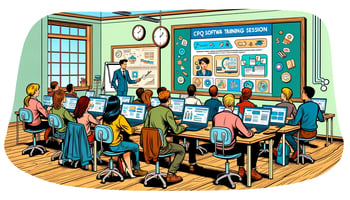In an era where data-driven decisions reign supreme, it’s time to embrace the virtual smartwatch...
Unleashing the Power of Nearest Neighbors in Sales Analytics
Imagine having a virtual smartwatch for sales that not only tracks the "health" of your sales reps but also keeps a pulse on your customers.
With machine learning and nearest neighbors vectors, this isn't just a dream—it's a reality.
By leveraging these advanced algorithms, we can gain deep insights into sales performance and customer behavior, optimizing every aspect of the sales process. In this post, we will dive into the technical aspects of nearest neighbors and explore how it can revolutionize your sales analytics.
Understanding Nearest Neighbors Vectors
Nearest neighbors is a type of instance-based learning where the model makes predictions based on the most similar past instances. This machine learning algorithm is non-parametric, meaning it doesn't assume a specific form for the underlying data distribution. Instead, it operates based on the idea that similar data points are likely to have similar outcomes. This approach is particularly useful in sales analytics for clustering similar customer profiles or identifying patterns in sales rep performance.
In technical terms, nearest neighbors works by calculating the distance between data points. The most common distance metric used is Euclidean distance, but other metrics like Manhattan or cosine distance can be used depending on the context. For a given data point, the algorithm identifies the 'k' nearest neighbors and uses their characteristics to predict the outcome for the new point.
Applications in Sales
Customer Segmentation
One of the primary applications of nearest neighbors in sales analytics is customer segmentation. By grouping customers with similar buying behaviors, businesses can create targeted marketing campaigns that resonate more effectively. For example, customers who frequently purchase high-end products might be grouped together, allowing the sales team to tailor premium offers specifically to them.
Nearest neighbors helps in identifying these segments by analyzing past purchase data and other relevant customer attributes. This data-driven approach ensures that marketing efforts are precise and impactful, leading to higher conversion rates and customer satisfaction.
Sales Forecasting
Accurate sales forecasting is crucial for planning and strategy. Nearest neighbors can predict future sales by comparing current sales data to historical trends. By identifying patterns in past sales performance, the algorithm can forecast future outcomes with a high degree of accuracy.
For instance, if certain sales reps consistently perform well during specific times of the year, nearest neighbors can use this information to predict future sales peaks and troughs. This allows businesses to allocate resources more efficiently, prepare for high-demand periods, and mitigate potential downturns.
Performance Tracking
Monitoring and improving sales rep performance is another key application of nearest neighbors. By comparing each rep's metrics to those of top performers, the algorithm provides actionable feedback for improvement. This can include identifying areas where a rep excels or needs additional training.
For example, if a sales rep is struggling with closing deals, nearest neighbors can highlight techniques used by top closers that the struggling rep can adopt. This continuous feedback loop ensures that all reps are performing at their best, ultimately boosting overall sales performance.
Technical Implementation
Data Preparation
The first step in implementing nearest neighbors for sales analytics is data preparation. This involves gathering and preprocessing data to ensure it’s clean, structured, and ready for analysis. Key data points might include sales figures, customer demographics, purchase history, and sales rep activities.
Data preprocessing steps might involve handling missing values, normalizing data, and encoding categorical variables. This ensures that the data is in a suitable format for the algorithm to process effectively.
Model Training
Once the data is prepared, the next step is model training. Using a k-Nearest Neighbors (k-NN) algorithm, we train the model on historical sales data. The value of 'k'—the number of neighbors to consider—is a crucial hyperparameter that needs to be optimized. Too small a value might lead to noise sensitivity, while too large a value might result in overly generalized predictions.
The training process involves feeding the algorithm with labeled data (where the outcomes are known) so it can learn to associate input features with the correct outcomes. This trained model can then be used to make predictions on new, unseen data.
Evaluation and Tuning
After training the model, it’s essential to evaluate its performance using appropriate metrics. Common evaluation metrics for nearest neighbors include accuracy, precision, recall, and F1 score. These metrics provide insights into how well the model is performing and where there might be room for improvement.
Hyperparameter tuning is also a critical step. This involves adjusting the parameters of the model (like the value of 'k') to achieve the best possible performance. Techniques like cross-validation can be used to ensure the model is robust and generalizes well to new data.
Harnessing the power of nearest neighbors vectors transforms sales analytics into a precise, insightful process. This virtual smartwatch for sales ensures that both sales reps and customers are monitored and nurtured for optimal results. By leveraging machine learning algorithms like nearest neighbors, businesses can make data-driven decisions that enhance customer engagement, improve sales forecasting, and boost sales rep performance.
The implementation of nearest neighbors in sales analytics is not without its challenges. Data quality, model tuning, and interpretation of results are crucial aspects that require careful attention. However, with the right approach and expertise, the benefits far outweigh the challenges, making it a valuable addition to any sales strategy.
To learn more about implementing nearest neighbors in your sales strategy, visit our detailed guide here. For personalized advice, book a virtual coffee with our experts Magnus and Patrik at cpq.se/meetcpqse.




